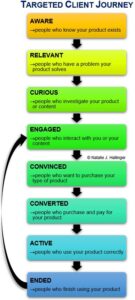Snag Your First Paying Client
as an Independent Consultant – Part 4
Beyond referrals, you will need to demonstrate your product’s relevance as a solution to people who require more rapport-building. This step in the Client Journey begins inviting potential clients that don’t have the benefit of a warm introduction.
First Clients Strategy #3
Get Leads from Fresh Outreach
At some point, you will exhaust all your referrals and will need to seek out and qualify other leads. Cold outreach can seem scary – that’s why I call it Fresh Outreach instead – but can be amazing if executed well. The key is targeting the right audience and personalizing the ask.
People avoid cold outreach because it is impersonal and intimidating. On the other hand, Fresh Outreach is a thoughtful invitation that builds curiosity. You respect your audience by understanding they have a choice. Instead of blindly pushing them toward purchase, you are aiding them in identifying whether the two of you would make good partners. Simultaneously, you should be vetting them to see if they are the targeted client you can serve best.
1. Create a Fresh Outreach strategy
Once more, no need to write a book. Even a simple outline or bulleted list is enough.
Define your goals for the Fresh Outreach campaign. Describe the outcomes you expect to get. Awareness? Engagement? Referrals? Qualified leads?
Identify the steps to achieve those goals. What is the single, most critical action you want people to take after being contacted? Does this action support your goals?
Decide which contact technique(s) you will use. What is typical for your type of product, company, or industry? If you were in the potential client’s position, which contact method would impress you the most? Phone call, email, direct message, live presentation, direct mail, etc.?
Draft a calling script or email template. What kind of ask will motivate people to take action? How can it be personalized?
2. Target the right audience
Do the work to identify or buy the contact lists to find people who have the problem that you are able to solve.
Budget for lead identification: locate contact list brokers for your industry and specify your target market
No budget for lead identification? Do the work manually to start. Search LinkedIn profiles, business registration lists, association member contact lists, etc.
3. Create messages that clarify your relevance to their ideal solution
People avoid cold-callers because they typically try to sell a product at all costs. The messages are aggressive, impersonal, sloppy, and not genuine. No one wants that.
For example, I get many daily emails from companies offering to redesign my website. Not one single email indicates they have even seen my website. They don’t mention the type of business I run, they don’t reference any pages with obvious problems, and they don’t specify what they think could be better. They just give a vague assurance that they can improve my site traffic. That isn’t even the outcome that I want.
Good Fresh Outreach starts with at least a little research on your target. You can only genuinely propose a beneficial partnership if you know your audience. What is their pain point? How do you know they are experiencing that particular pain point? Is that pain point an important issue to address right now? What would be the impact of resolving that pain point?
Not sure what or how to craft a script/message? Think about the last cold call you received. What could they have said that would make you eager to respond? Not necessarily a purchase, but what would have made you curious? Is there anything that would prompt you to visit their website, call back, respond to their email, etc.? You don’t need to be a seasoned copywriter. Get started using your own experiences as a guide or partner with a coach to build your skills.
4. Deploy and track the Fresh Outreach campaign
Activate your plan and measure how it progresses. Are some groups easier to reach? Are they more interested in hearing more? Is a particular script working poorly?
Tracking the client relationships as they develop is key. The more you know about your potential client, the better you can target information or products they actually want. Solving a problem they actually need addressed is much easier than pretending to be relevant for the sake of a sale. Your relationship will help signal what the potential client wants, where you can be helpful, and when they are in the best position for a partnership.
Be sure to track whether the outreach is changing the outcomes you targeted. If you want to repeat this campaign in the future, you definitely want records of what worked. No need for complex spreadsheets unless you enjoy and have the skills for that kind of recordkeeping. Even occasional notes about campaign progress or setbacks will help future campaigns be more successful without starting from scratch.
-
-
- Part 1 – Targeted Client Journey
- Part 2 – First Clients Strategy #1: Get Client Referrals from Your Network
- Part 3 – First Clients Strategy #2: Get Work or Testimonials from Past Employers and Coworkers
- Part 4 – First Clients Strategy #3: Get Leads from Fresh Outreach
- Part 5 – First Clients Strategy #4: Engage Leads with Meaningful Content
-


Comments are closed, but trackbacks and pingbacks are open.